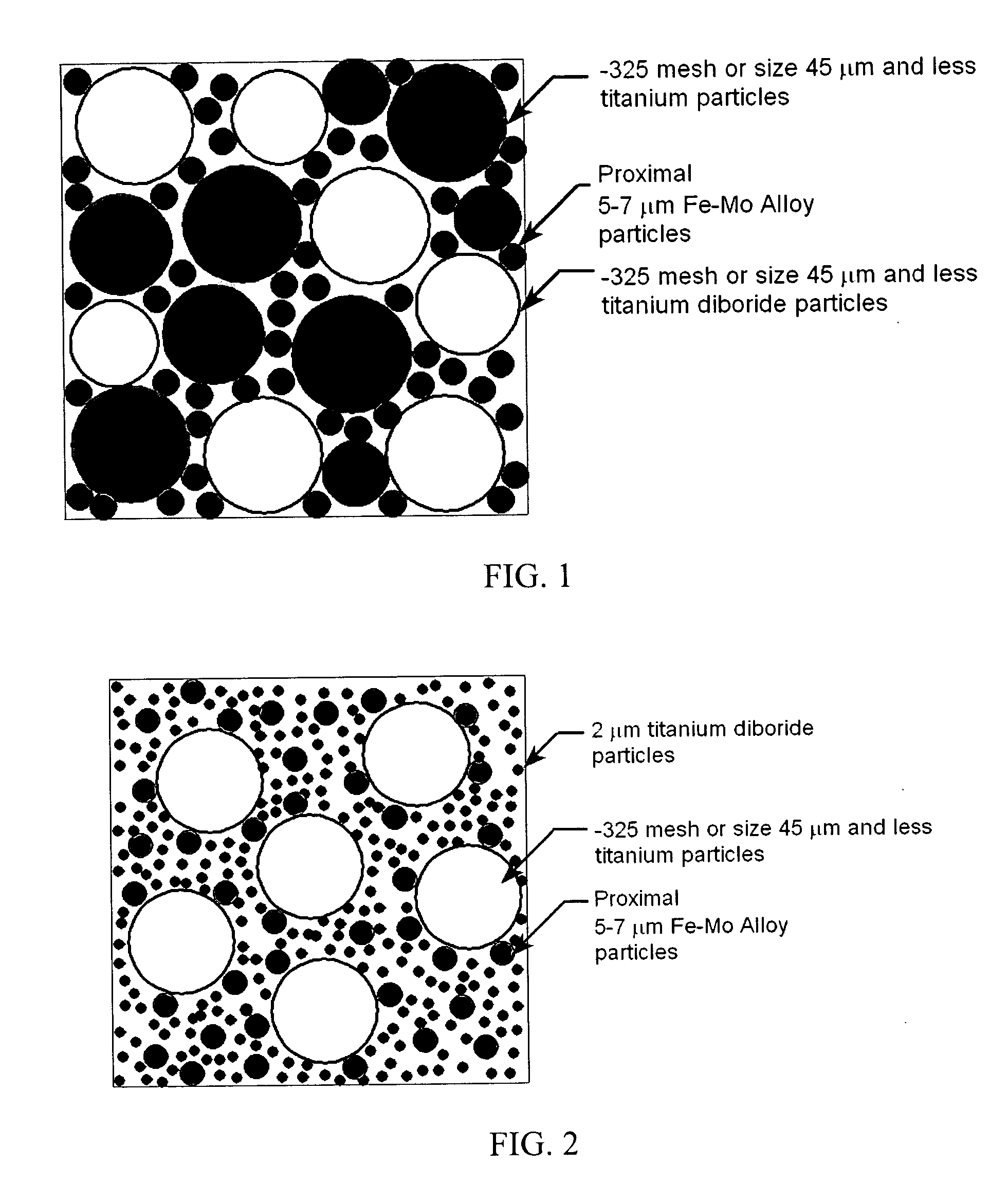Nanostructured titanium monoboride monolithic material and associated methods
a titanium monoboride and monolithic material technology, applied in the direction of conductive materials, crystal growth process, chemically reactive gases, etc., can solve the problems of high manufacturing cost, high manufacturing cost, and low availability of borides, and achieve high strength, high manufacturing efficiency, and machinability. the effect of easy operation
- Summary
- Abstract
- Description
- Claims
- Application Information
AI Technical Summary
Benefits of technology
Problems solved by technology
Method used
Image
Examples
example 1
[0073] A powder mixture of titanium diboride (TiB2) powder, titanium (Ti) powder and an iron-molybdenum alloy (FeMo) powder were used to synthesize the nanostructured monolithic titanium boride (TiB). FeMo alloy powder is employed as the densifier.
[0074] Table 1 provides a compilation of the Ti—TiB2—FeMo compositions (wt. %) that have been synthesized in the laboratory. All the compositions contain 15 grams of the densifier, Fe—Mo, but with different proportions of Ti and TiB2 powders to identify correlations of various properties.
TABLE 1CompositionsTi—TiB2—FeMo (grams)Sample Identity135-159-15SM 19140-159-15SM 16145-159-15SM 18152-159-15SM 12157-159-15SM 11162-159-15SM 9
[0075] The powder mixture uses titanium powders of average size of −325 mesh (particle sizes including 45 μm and below and chemical composition in wt. %: 0.23 O, 0.02 N, 0.01 C, 0.04 Fe, and 0.024H; balance Ti), titanium diboride powders of average size 2 μm (chemical composition in wt. %: 30.3 B, 0.67 Zr, 0.01 ...
example 2
[0082] A powder mixture was made of titanium diboride (TiB2) powder, titanium (Ti) powder and an iron-molybdenum alloy (Fe—Mo) powder to synthesize the nanostructured monolithic titanium boride (TiB). The same powders were used as in Example 1, except both the titanium and the titanium diboride powders were −325 mesh (sizes of 45 μm and below including different proportions of particle sizes down to about 1 μm), which are readily commercially available forms. A composition of Ti—TiB2—FeMo: 157-159-15 (grams) was used to synthesize the nanostructured titanium boride under the same conditions as in Example 1. The resulting material was microstructurally quite similar to the material made in Example 1, and is expected to exhibit similar properties. FIGS. 9A and 9B are optical pictures (magnified at 200× and 1000×, respectively) of the microstructures for the nanostructured titanium boride synthesized which illustrate more clearly the network of whiskers which comprise the bulk of the m...
example 3
[0083] Preparation
[0084] A nanostructured titanium monoboride was manufactured by carefully controlled reaction sintering of a tri-modal distribution of Ti and TiB2 powders. The relative powder sizes were important in obtaining the desired nanostructure in the final TiB material. A bi-modal titanium powder mixture having an average size of 45 μm and 7 μm and a composition of (wt. %) 0.23 O, 0.02 N, 0.01 C, 0.04 Fe, and 0.024H and titanium diboride powders having an average size of 2 μm and a composition of (wt. %) 30.3 B, 0.67 Zr, 0.01 C, 0.04 Fe, and 0.024H were provided. The titanium powder and titanium diboride powders were mixed together at 49 wt % Ti (41±2 wt % of 45 μm size and 9±1 wt % of 7 μm size powder) and 51 wt % TiB2. The powders were then thoroughly blended for 24 hours in a rotary blender with steel balls to ensure homogeneity of the mixture. These powders have a size ratio of 45:7:2, and a packing density of about 90% in the blended state, which was found to be impo...
PUM
| Property | Measurement | Unit |
|---|---|---|
| diameter | aaaaa | aaaaa |
| diameter | aaaaa | aaaaa |
| temperatures | aaaaa | aaaaa |
Abstract
Description
Claims
Application Information
 Login to View More
Login to View More - R&D
- Intellectual Property
- Life Sciences
- Materials
- Tech Scout
- Unparalleled Data Quality
- Higher Quality Content
- 60% Fewer Hallucinations
Browse by: Latest US Patents, China's latest patents, Technical Efficacy Thesaurus, Application Domain, Technology Topic, Popular Technical Reports.
© 2025 PatSnap. All rights reserved.Legal|Privacy policy|Modern Slavery Act Transparency Statement|Sitemap|About US| Contact US: help@patsnap.com



